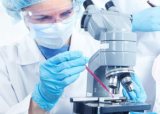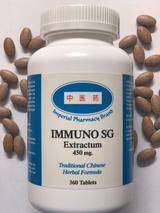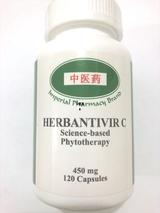|
ARTEMISININ IS A SELECTIVE CYTOTOXIC ANTIMALARIA AND ANTICANCER THERAPY:
Artemisia Anua "Qing Hao" is an herb used in Traditional Chinese Medicine for the treatment of malaria, intestinal worms, febrile diseases, and malignancy. Artemisinin is the active ingredient of Artemisia Anua, and it is one of the most effective treatments so far known against malaria. Scientific studies have proven that artemisinin has selective cytotoxic action against iron overloaded cancer cells.
Many methods of administration reveal different levels of absorption and bioavailability of artemisinin in the body. Oral artemisinin, while suitable for the treatment of malaria, is not a very effective form of administration when used as a wide spectrum antitumor therapy. Due to the fast and progressive reduction in the G.I. absorption of artemisinin, its bioavailability in the body diminishes within a few days of oral administration.
The intramuscular, intravenous, and intraperitoneal administration of artemisinin bypass GI absorption and secure bioavailability in the body. The bioavailability levels of artemisinin in the body and the metabolizing rate depend on its derivative forms (Artesunate, Artemether, Dehydroartemisinin, etc.), dosage (ratio/body weight), and way of administration.
Artemisinin is an effective antitumor therapy that has little to non side effect when used properly. Qing Hao (Artemisia Annua) and its derivates are used in Traditional Chinese Medicine (TCM) to treat patients with malaria, febrile illnesses, tumors, heat ulcerations, and yin deficiencies.
Internationally, Artemisinin is a known "powerful" antimalaria medication. In the United States, a particular form of Artemisinin drug that is mixed with Lumefantrine, a blood schizonticide active against erythrocytic stages of Plasmodium falciparum, has been recently approved as a conventional treatment for malaria (Artemisinin/Lumefrantine is not totally artemisinin and it has not known antitumor application).
Dr. Marcelo Lam is one of the physicians with more knowledge and experience on the use of artemisinin in cancer patients. Dr. Lam's protocol of administering systemic artemisnin for antitumor application has been adopted by some of the world's leading oncologists. Artemisinin can be provided as a single alternative therapy or in combination with conventional treatments. In China, artemisinin is also available in combination with Gendicine and Oncorine (H101) (gene antitumor treatments), Endostar, hyperthermia, HIFU (high intense focused ultrasound), Kanglaite, and other high tech anticancer therapies.
Artemisinin has shown effective antitumor action and it is available as an anticancer treatment abroad. Antitumor therapy with Artesunate i.v. can be received alone or in combination with conventional anticancer therapies at medical facilities in South Korea, the Dominican Republic, and China.
In the United States, the professional use and administration of TCM herbal medicine is regulated by the scope of practice of Oriental Medicine according to the law of each State. Some ways of herbal administration may not be available in the U.S., or are limited according to the law in each different State. The FDA has not evaluated this information on herbal medicine, and this information is intended for educational purpose only.
Review of some scientific data published on the use of Artemisinin, and Artemisinin related medicines:
Reference:
International Journal of Experimental and Clinical Pharmacology
Vol. 82, No. 2, 2008
Artemisinin Inhibits Tumor Lymphangiogenesis by Suppression of Vascular Endothelial Growth Factor C, Jun Wanga, Bicheng Zhanga, b, Yan Guoa, Guanghui Lia, Qichao Xiea, Bo Zhua, Jianfei Gaob, Zhengtang Chena. Cancer Institute of People's Liberation Army, Xinqiao Hospital, Third Military Medical University, Chongqing, PR China.
We have previously reported that dihydroartemisinin is found to have a potent ability in influencing lymphatic endothelial cell migration and tube formation. In this study, we investigated the effect of artemisinin on tumor growth, lymphangiogenesis, metastasis and survival in mouse Lewis lung carcinoma (LLC) models. We found that orally administered artemisinin inhibited lymph node and lung metastasis and prolonged survival without retarding tumor growth. Consistent with the decrease in lymph node metastasis, tumor lymphangiogenesis and expression of vascular endothelial growth factor C (VEGF-C) was significantly decreased in artemisinin-treated mice, as compared to control mice. Furthermore, IL-1beta-induced p38 mitogen-activated protein kinase (MAPK) activation and upregulation of VEGF-C mRNA and protein in LLC cells was also suppressed by artemisinin or by the p38 MAPK inhibitor SB-203580, suggesting that p38 MAPK could serve as a mediator of proinflammatory cytokine-induced VEGF-C expression. These data indicate that artemisinin may be useful for the prevention of lymph node metastasis by downregulating VEGF-C and reducing tumor lymphangiogenesis. Copyright 2008 S. Karger AG, Basel.
A CANCER TREATMENT METHOD
All cancer cells need plenty of iron to multiply. In other words, cancer cells have a much higher iron concentration than normal cells. During the study, the researchers pumped cancer cells with maximum iron concentrations and then injected artemisinin into them. The results revealed that artemisinin had the properties of killing and inhibiting cancer cells.
(US Patent Document 5,578,637, University of Washington, inventors Dr H.Lai and Dr NP Singh, November 26 1996.)
CELL OF A HUMAN LEUKEMIA CELL LINE
In another study, researcher Dr Lai noted even more amazing results involving leukemia cells. He mentioned that the cancer cells were destroyed very quickly within a few hours when exposed to holotransferrin (which binds with transferring receptors to transport iron into cells) and dihydroartemisinin (a more water-soluble form of artemisinin). He further explained that it might be because of the high concentration of iron in the leukemia cells.
(H.Lai and NP Singh, Selective Cancer Cell Cytoxicity from Exposure in Dihydroartemisinin and Holotransferrin, Cancer Letters, 91:41-46, 1995)
55 CANCER CELL LINES
This amazing herb was also examined for its activity against 55 cancer cell lines. It was found to be the most active against leukemia and colon cancer and active against melanomas, breast cancer, prostate cancer, CNS and renal cancer. It was also reported that artemisinin's effectiveness was comparable with other standard drugs used to combat cancer. As such, these results and the low toxicity of artemisinin had made this herb to be a potential for cancer chemotherapy. (Efferth et al, Anti-Malaria Drug is Also active against cancer, Int'l Journal of Oncology, 18;767-773,2001.)
BREAST CANCER CELLS
This herb becomes cytotoxic in the presence of ferrous iron. To accommodate a rate of iron intake greater than normal cells, cancer cells surfaces feature greater concentrations of transferrin receptors- cellular pathways that allow iron into a cell. In breast cancer cells, they have 5 to 15 times more transferrin receptors on their surface than normal breast cells. During a recent study, both breast cancer cells as well as normal cells were injected with artemisinin. The results showed that artemisinin effectively killed radiation-resistant breast cancer cells in vitro. However, the effects on the normal breast cells were minimal.This simply goes to show that this herb might be a simple, effective and economical treatment for cancer. (NP Singh and H Lai, Selective toxicity of dihydroartemisinin and holotransferrin toward human breast cancer cells. Life Sciences, 70:49-56,2001)
SMALL-CELL LUNG CARCINOMA CELLS (SCLC)
When artemisinin was tested on drug sensitive (H69) and multi-drug resistant (H69VP) SCLC cells which were actually injected with transferrin to raise the iron concentration levels, it was found that the cytotoxicity of artemisinin for H69VP cells was ten times lower than for H69 cells. This concluded that artemisinin was part of the drug resistance phenotype. This experiment also indicated that pretreatment of H69 did not lower the iron concentration for artemisinin whereas for H69 VP cells, the iron concentration was lowered to near drug sensitive levels. The researchers therefore concluded that artemisinin could be used together with transferin in drug resistance SCLC. (Sadava, D et al, Transferrin overcomes drug resistance to artemisinin in human small cell lung carcinoma cells, Cancer Letter, 179,151-156, 2002)
ENHANCED EFFECTIVENESS OF CHEMOTHERAPY
Various studies carried out separately in Germany and Australia, revealed the activities of twenty drugs on leukemia CCRF-CEM cells lines, artemisinin, artesuante, balcalein, baicalin, barberine, bufalin, cantharidin, cephalotaxine, curcumin, daidzein, daidzin, diallyl, disulfide, ginsenoside, Rh2, glycirrhizic acid, isonardosinon, homoharringtonine, nardosinon, nardofuran, puerarin, quercetin, tannic acid and tetrahydronardosinon. The results showed that artesunate increased daunorabicin accumulation in CEM/E1000 cells. As artesunate and bufalin both have abilities to combat leukemia, whether it was applied alone or together with daunonrubicin in multi-resistant cells, these two drugs might be suitable for treating leukemia in the near future. (Efferth et al, Blood Cells, Molecules, and Diseases 28(2) Mar/April; 160-168, 2002)
MODULATION OF MULTIDRUG RESISTANCE FOR CHEMOTHERAPY
Arteminisin could prevent the spread of cancer cells and increase cytotoxicity of perarubicin and doxorubicin in P-glycoprotein-overexpressing, and in MRP- overexpressing, but not in their corresponding drug sensitive cell lines. (Reungpatthanaphong, P et al Modulation of MDR by Artemisinin, artesunate and DHA in K562, GLC4 Resistant cell lines, Biology Pharmocology Bull. 25(12) 1555-1561, 2002)
5 CANCER CELL LINES
When a triterpene and a sesquiterpene were isolated from separation of artemisia stolonifera, both of them proved to be able to destroy cancer cells in non-small cell lung adenocarcinorma, ovarian cancer, skin melanoma, CNS and colon cancer. (Kwon, Phytochemical constituents of Artemisia stolonifera, Arch.Pharm, Research 24(4):312-315,2001)
ANTI-TUMOR EFFECT
When artemisinin's derivative, 9 C-10 was prepared as dimers using novel chemistry, it proved to be able tokill malaria cells. Additionally, dimers 8, 10 and 12 were especially powerful and prevented cancer growth in the NCI in vitro 60 cell line assay. (Posner, GH et al, Antimalarial, antiproliferative and antitumor activities of Artemisin Derived Dimers, J Medicinal Chemistry, 42(21), 178-181, Oct 1999)
LEUKEMIA AND NON SMALL-CELL LUNG CARCINOMA CELL LINES
Researchers discovered a novel class of compounds that could destroy cancer cells after modifying artemisinin in one of the experiments conducted recently. This new derivative contained cyano and aryl groups and was very effective in destroying leukemia and human lung carcinoma cells. (Li, Ying, et al, Novel antitumor artemisinin derivatives targeting G1 phase of the cell cycle, Bioorganic and Medicinal chemistry letters 11:5-8, 2001)
TUMOR CELLS
Some artemisinin related endoperoxides that were tested on their abilities to destroy Ehrlich ascites tumor cells (EAT) were proven positive. Surprisingly, its derivatives were even more powerful at destroying cancer cells. This test also confirmed artemisinin and its derivaties abilities to kill EAT cells at higher concentration than those needed for in vitro anti-malaria activities. (Woerdenbag, HJ et al. Cytotoxicity of artemisinin-related endoperoxides to EATcells, J Natural Products 56(6), 849-856, 1993)
BLOOD-BRAIN BARRIER & ALZELMER'S DISEASE (AD)
Although artemisinin could not be dissolved in water, it was able to cross the blood brain barrier. It might therefore be useful for curing brain tumors and other brain diseases.
During a recent experiment, an alkaloid of artemisia asiatica was metabolized to small molecules in the digestive tract and was passed through the blood brain barrier. The results showed that it could act as an acetylcholinesterase inhibitor with a blocker of neuroloxicity induced by a beta in human beings that caused AD. (Heo et al, Inhibitory effects of Artemesia alkaloids on acetylcholine sterase activity from PC12 cells, molecule cells, Jun 30:10(3):253-262)
Clinical Trials On The Use of Artemisinin
HUMAN LARYNX CANCER TREATMENT
In this case, the patient was given artesunate injections and tablets over a period of nine months. His tumor was significantly reduced by about 70 percent just after two months of treatment. The patient also reported that he benefited much from this treatment. It actually prolonged his life and improved his quality of life. Once again, artemisinin had proven its amazing properties in killing cancer cells. (Singh and Verma, Case report of a laryngeal squamous cell carcinoma treated with artesunate, Archive of Oncology, Vol 10(4), 279-80, 2002)
TOXICITY OF ARTEMISININ
STUDY ON LARGE ANIMALS
Investigating if high doses of artemisinin could produce neurotixicity such as ding gait disturbances, loss of spinal and pain response, respiratory depression and ultimately cardiopulmonary arrest in large animals.
When artemisinin was given to monkey at 292 mg/kg over 1 to 3 months, they showed no toxicity. (Journal of Traditional Chinese Medicine 2(1) : 31-36, 1982)
HEALTHY VOLUNTEERS
In pharmacokinetic studies, 250 mg tablets of artemisin and artesunate tablets were used. Both forms of tablets were well tolerated and there were no negative side effects. (Benakis et al. Pharmacokinetics of artemisinin and artesunate after oral administration in healthy volunteers. American Journal of Tropical Medicine Hyg, Jan;56(1): 17-23, 1997)
PHARMACOKINETICS
During a study, healthy volunteers were given 250 mg of tablets of artemisinin and artesunate orally. Thee researchers reported that in the case of Artemisinin, the mean maximun drug concentration C= 0.36 microgram/ml, appearance half life T-0.62 hr, distribution hal life t(12) a= 2.61 hr, decline half life t(12) = 4.34 hr, total area under concentration curve (AUC) =1.10 microgram hg/ml its main metabolite, dihydroartemisinin was measured in plasma. On the other hand, half lives were more shorter in the case of artesunate (a syntetic form of the drug). (Benakis, et al, Dept of Pharmacology, Geneva U Swiss, Am J Trop Med Hyg, Jan; 56(1): 17-23, 1997.
Publications Relating to Effects of Artemisinin and its Analogs on Cancer Cells
-
Beekman AC, Barentsen AR, Woerdenbag HJ, et al: Stereochemistry-dependent cytotoxicity of some artemisinin derivatives. J Nat Prod 60:325-330, 1997.
-
Beekman AC, Wierenga PK, Woerdenbag HJ, et al: Artemisinin-derived sesquiterpene lactones as potential antitumour compounds: cytotoxic action against bone marrow and tumour cells. Planta Med 64:615-619, 1998.
-
Beekman AC, Woerdenbag HJ, Van Uden W, et al: Stability of artemisinin in aqueous environments: impact on its cytotoxic action to Ehrlich ascites tumour cells. J Pharm Pharmacol 49:1254-1258, 1997.
-
Bhisutthibhan J, Philbert MA, Fujioka H, Aikawa M, Meshnick SR: The Plasmodium falciparum translationally controlled tumor protein: subcellular localization and calcium binding. Eur J Cell Biol 78:665-670, 1999.
-
Chen HH, Zhou HJ, Fang X: Inhibition of human cancer cell line growth and human umbilical vein endothelial cell angiogenesis by artemisinin derivatives in vitro." Pharmacol Res 48: 231-236, 2003.
-
Efferth T, Dunstan H, Sauerbrey A, et al: The anti-malarial artesunate is also active against cancer. Int J Oncol 18:767-773, 2001.
-
Efferth T, Davey M, Olbrich A, et al.: Activity of drugs from traditional Chinese medicine toward sensitive and MDR1- or MDR1-overexpressing multidrug-resistant human CCRF-CEM leukemia cells. Blood Cells, Molecules, and Diseases 28:160-168, 2002.
-
Efferth T, Olbrich A, Bauer R: mRNA expression profiles for the response of human tumor cell lines to the antimalarial drugs artesunate, arteether, and artemether. Biochem Pharmacol 64:617-623, 2002.
-
Fishwick J, Edwards G, Ward SA, et al: Binding of dihydroartemisinin to differentiating neuroblastoma cells and rat cortical homogenate. Neurotoxicology 19:405-412, 1998.
-
Fishwick J, Edwards G, Ward SA, et al: Morphological and immunocytochemical effects of dihydroartemisinin on differentiating NB2a neuroblastoma cells. Neurotoxicology 19:393-403, 1998.
-
Hu YQ, Tan RX, Chu MY, et al: Apoptosis in human hepatoma cell line SMMC-7721 induced by water-soluble macromolecular components of Artemisia capillaris Thunberg. Jpn J Cancer Res 91:113-117, 2000.
-
Lai H, Singh NP: Selective cancer cell cytotoxicity from exposure to dihydroartemisinin and holotransferrin. Cancer Lett 91:41-46, 1995.
-
Lee CH, Hong H, Shin J, et al.: NMR studies on novel antitumor drug candidates, deoxoartemisinin and carboxypropyldeoxoartemisinin. Biochem Biophys Res Comm 274:359-369, 2000.
-
Li Y, Shan F, Wu JM, et al: Novel antitumor artemisinin derivatives targeting G1 phase of the cell cycle. Bioorg Med Chem Lett 11:5-8, 2001.
-
McLean WG, Ward SA: In vitro neurotoxicity of artemisinin derivatives. Med Trop (Mars) 58:28-31, 1998.
-
Moore JC, Lai H, Li JR, et al: Oral administration of dihydroartemisinin and ferrous sulfate retarded implanted fibrosarcoma growth in the rat. Cancer Lett 98:83-87, 1995.
-
Mukanganyama S, Widersten M, Naik YS, et al: Inhibition of glutathione S-transferases by antimalarial drugs possible implications for circumventing anticancer drug resistance. Int J Cancer 97:700-705, 2002.
-
Oh S, Jeong IH, Shin WS, Lee S: Growth inhibition activity of thioacetal artemisinin derivatives against human umbilical vein endothelial cells. Bioorg Med Chem Lett 3(21):3665-3668, 2003.
-
Posner GH, Ploypradith P, Parker MH, et al: Antimalarial, antiproliferative, and antitumor activities of artemisinin-derived, chemically robust, trioxane dimers. J Med Chem 42:4275-4280, 1999.
-
Reungpatthanapong P, Mankhetkorn S: Modulation of multidrug resistance by artemisinin, artesunate and dihydroartemisinin in K562/adr and GLC/adr resistant cell lines. Biol Pharm Bull 25:1555-1561, 2002.
-
Sadava D, Phillips T, Lin C, et al: Transferrin overcomes drug resistance to artemisinin in human small-cell lung carcinoma cells. Cancer Lett 179:151-156, 2002.
-
Shaikenov TE, Adekenov SM, Williams RM, et al: Arglabin-DMA, a plant derived sesquiterpene, inhibits farnesyltransferase. Oncol Rep 8:173-179, 2001.
-
Singh NP, Lai H: Selective toxicity of dihydroartemisinin and holotransferrin toward human breast cancer cells. Life Sci 70:49-56, 2001.
-
Singh NP, Verma KB: Case report of a laryngeal squamous cell carcinoma treated with artesunate. Arch Oncol 10:279-280, 2002.
-
Smith SL, Maggs JL, Edwards G, et al: The role of iron in neurotoxicity: a study of novel antimalarial drugs. Neurotoxicology 19:557-559, 1998.
-
Sun WC, Han JX, Yang WY, et al: [Antitumor activities of 4 derivatives of artemisic acid and artemisinin B in vitro]. Zhongguo Yao Li Xue Bao 13:541-543, 1992.
-
Woerdenbag HJ, Merfort I, Passreiter CM, et al: Cytotoxicity of flavonoids and sesquiterpene lactones from Arnica species against the GLC4 and the COLO 320 cell lines. Planta Med 60:434-437, 1994.
-
Woerdenbag HJ, Moskal TA, Pras N, et al: Cytotoxicity of artemisinin-related endoperoxides to Ehrlich ascites tumor cells. J Nat Prod 56:849-856, 1993.
-
Wu JM, Shan F, Wu GS, et al: Synthesis and cytotoxicity of artemisinin derivatives containing cyanoarylmethyl group. Eur J Med Chem 36:469-479, 2001.
-
Zheng GQ: Cytotoxic terpenoids and flavonoids from Artemisia annua. Planta Med 60:54-57, 1994.
Artemisinin Pharmacology and Pharmacokinetics
-
Dhingra V, Rao KV, Narasu NL: Current status of artemisinin and its derivatives as antimalarial drugs. Life Sci 66:279-300, 2000.
-
Li Y, Wu YL: An over four millennium story behind qinghaosu (artemisinin--a fantastic antimalarial drug from a traditional chinese herb). Curr Med Chem 10(21):2197-2230, 2003.
-
Navaratnam V, Mansor SM, Sit NW, et al: Pharmacokinetics of artemisinin-type compounds. Clin Pharmacokinet 39:255-270, 2000.
Links:
http://www.mwt.net/~drbrewer/canart2.htm
http://www.townsendletter.com/Dec2002/artemisinin1202.htm
Back
|
| |








